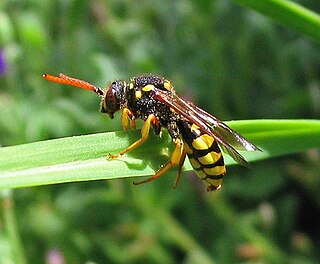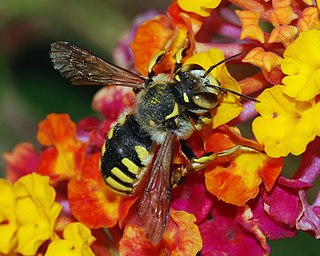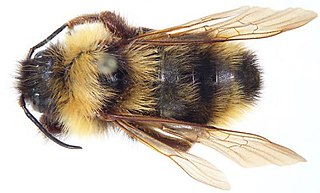
A pollinator is an animal that moves pollen from the male anther of a flower to the female stigma of a flower. This helps to bring about fertilization of the ovules in the flower by the male gametes from the pollen grains.

Megachilidae is a cosmopolitan family of mostly solitary bees whose pollen-carrying structure is restricted to the ventral surface of the abdomen. Megachilid genera are most commonly known as mason bees and leafcutter bees, reflecting the materials from which they build their nest cells ; a few collect plant or animal hairs and fibers, and are called carder bees, while others use plant resins in nest construction and are correspondingly called resin bees. All species feed on nectar and pollen, but a few are kleptoparasites, feeding on pollen collected by other megachilid bees. Parasitic species do not possess scopae. The motion of Megachilidae in the reproductive structures of flowers is energetic and swimming-like; this agitation releases large amounts of pollen.

The pollen basket or corbicula is part of the tibia on the hind legs of certain species of bees. They use the structure in harvesting pollen and carrying it to the nest or hive. Other species of bees have scopae instead.

The name squash bee, also squash and gourd bee, is applied to two related genera of bees in the tribe Eucerini; Peponapis and Xenoglossa. Both genera are oligoleges on the plant genus Cucurbita and closely related plants, although they usually do not visit watermelon, cucumber, and melon plants. They are small genera, containing only 13 and 7 described species, respectively, and their combined range is nearly identical to the range of Cucurbita in the New World, from South America to North America. Their range has become somewhat expanded along with the movement of cucurbits into other areas.

With over 850 species, the genus Nomada is one of the largest genera in the family Apidae, and the largest genus of kleptoparasitic "cuckoo bees." Kleptoparasitic bees are so named because they enter the nests of a host and lay eggs there, stealing resources that the host has already collected. The name "Nomada" is derived from the Greek word nomas (νομάς), meaning "roaming" or "wandering."

Anthidium is a genus of bees often called carder or potter bees, who use conifer resin, plant hairs, mud, or a mix of them to build nests. They are in the family Megachilidae which is cosmopolitan in distribution and made up of species that are mostly solitary bees with pollen-carrying scopa that are only located on the ventral surface of the abdomen. Other bee families have the pollen-carrying structures on the hind legs. Typically species of Anthidium feed their brood on pollen and nectar from plants. Anthidium florentinum is distinguished from most of its relatives by yellow or brick-red thoracic bands. They fly all summer and make the nests in holes in the ground, walls or trees, with hairs plucked from plants.

Bombus sylvestris, known as the forest cuckoo bumblebee or four-coloured cuckoo bee, is a species of cuckoo bumblebee, found in most of Europe and Russia. Its main hosts are Bombus pratorum, Bombus jonellus, and Bombus monticola. As a cuckoo bumblebee, Bombus sylvestris lays its eggs in another bumblebee's nest. This type of bee leaves their young to the workers of another nest for rearing, allowing cuckoo bumblebees to invest minimal energy and resources in their young while still keeping the survival of their young intact.

Bombus suckleyi is a species of bumblebee known commonly as Suckley's cuckoo bumblebee, named after biologist George Suckley. Suckley's bumble bee is a generalist pollinator and represents a rare group of obligate, parasitic bumble bees. Suckley's bumble bee is a social-parasite because it invades the nests of the host bumble bees, including the western bumble bee, and relies on host species workers to provision its larvae. It is native to northwestern North America, including Alaska and parts of western and central Canada and the western United States.

Bombus vosnesenskii, the yellow-faced bumblebee, is a species of bumblebee native to the west coast of North America, where it is distributed from British Columbia to Baja California. It is the most abundant species of bee in this range, and can be found in both urban and agricultural areas. Additionally, B. vosnesenskii is utilized as an important pollinator in commercial agriculture, especially for greenhouse tomatoes. Though the species is not currently experiencing population decline, urbanization has affected its nesting densities, and early emergence of the B. vosnesenskii has been implicated in the increasing lack of bee diversity on the West coast.

Amegilla quadrifasciata, the white-banded digger bee, is a species of bee belonging to the family Apidae subfamily Apinae.

Anthophora dispar is a species of bee belonging to the family Apidae subfamily Apinae tribus Anthophorini.

Bombus ruderarius, commonly known as the red-shanked carder bee or red-shanked bumblebee, is a species of bumblebee found in Eurasia.

Sphecodopsis is a genus of cleptoparasitic "cuckoo" bees in the family Apidae. Endemic to southern Africa, the wasp-like bees of this genus are generally small, varying from 3.9 to 9 mm in length, and mostly black, with orange-ish or reddish colouring of the metasoma in some of the species. The bee genus Scrapter is recognised as a host for the cleptoparasitic life cycle of some Sphecodopsis, but further data regarding preferred hosts is not available for most of the species.

Peponapis pruinosa is a species of solitary bee in the tribe Eucerini, the long-horned bees. Its common name is eastern cucurbit bee. It may be called the squash bee, but this name can also apply to other species in its genus, as well as the other squash bee genus, Xenoglossa. This bee occurs in North America from the East Coast of the United States to the West Coast and into Mexico. It is an oligolege, specializing on a few host plants, the squashes and gourds of genus Cucurbita. Its range expanded as human agriculture spread throughout North America and squash plants became more abundant and widespread. It may also have spread naturally as the range of its favored wild host plant Cucurbita foetidissima expanded.

The genus Systropha comprises several species of Old World sweat bees, primarily specialist pollinators of plants in the genus Convolvulus. Males of the genus have unusual curled antennae, and females have pollen-carrying hairs covering almost the entire abdomen.

Megachile melanophaea is a species of leaf-cutter bee in the family Megachilidae. It was first described by the British zoologist Frederick Smith in 1853. It is native to North America.

Ptilothrix is a genus within the tribe Emphorini of the family Apidae. Bees of this genus can range from 7 to 15 millimeters. Ptilothrix species are solitary ground nesting bees. The genus has especially prominent hairs in the scopae of their hind legs, to help gather pollen to provision their nests. Ptilothrix specialize on certain families of plants for their pollen, including the families Malvaceae, Convolvulaceae, Onagraceae, Cactaceae, Pontederiaceae and Asteraceae. The genus is found in the new world, with species ranging from North to South America.

Macropis nuda is a ground nesting, univoltine bee native to northern parts of North America. Thus, this species cocoons as pupae and hibernates over the winter. The species is unique as it is an oligolectic bee, foraging mainly for floral oils from Primulaceae of the genus Lysimachia.

Osmia caerulescens, the blue mason bee, is a species of solitary bee from the family Megachilidae. It has a Holarctic distribution extending into the Indomalayan region, although its presence in the Nearctic may be due to human assisted introduction.

Andrena scotica, the chocolate mining bee or hawthorn bee, is a species of mining bee from the family Andrenidae. It occurs in western Europe and is one of the most frequently encountered mining bees found in Great Britain, where it had been previously misidentified as Andrena carantonica.






















